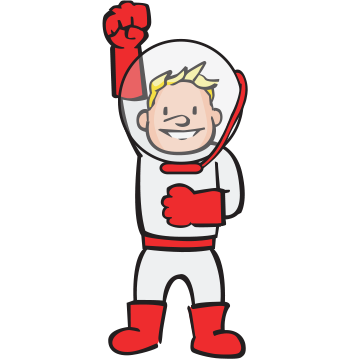Boston Children's Museum
308 Congress Street, Boston, MA 02210
617-426-6500
© Boston Children’s Museum 2025
Website Design by JackrabbitDesign challenges are a great way for kids to develop a range of skills, like problem solving, communicating, observing, comparing, measuring, estimating, and lots more. This challenge, which is best for your older students, also asks children to examine properties of materials, practice engineering design, and learn about the properties of planets in our solar system.
This activity is best for students ages 8 and up, though you could certainly run it with younger children, with some adaptation.
Before the session starts, decide what planet you would like to have students concentrate on for this session. It could be one or more than one. Review the Planet Facts before you decide. You could also have your students vote on the chosen planet, if you’d like; or, you could even review all of the planets with the whole group, and let individual teams decide which planet they would like to focus on.
Print out a copy of the Planet Facts sheets (click here) for each team. Alternatively, you can pick a few of the facts to write down on a piece of chart paper, whiteboard, etc. where everyone can see them. These facts are intended to help inspire ideas in your children’s designs. For younger children, a long list of facts might be distracting, so gauge your class and choose accordingly.

Ask your students if they have ever heard the word “design” before. What does it mean to design something?
Design is creative problem-solving. Designers figure out a need (for example, creating a helmet that can protect kids while they ride their bikes); and they try to solve that challenge in the best way that they can. For example, a helmet for kids has to be strong, but can’t be too heavy. It can’t be so expensive that no one could buy it. And it can’t be made out of a material that is very hard to find. It has to feel comfortable to wear, and it even should look good. There are lots of design factors that designers need to think about!
Choose an object in your classroom that was designed (should be easy…if it’s not an apple, a hamster or something else natural…then someone designed it). Ask your students to answer these questions about it:
Tell your students that you would like them to design a home/habitat, a form of transportation, an outfit, or an object that accomplishes a task (you can choose one of these ahead of time, or have each team choose one).
Create a habitat, form of transportation, object, or outfit to be used on an imaginary trip to one of the planets.
Once each team has a few ideas on paper, bring the larger group together to talk about their ideas (alternatively, some afterschools running this activity have had teams pair up, and share ideas and challenges with each other, rather than having a whole group discussion. After the activity was done, they held a large group sharing session). Ask teams to share the following with each other:
Give them a few minutes to talk together about how they’ll present this information, then give each team time to present. Encourage other teams to ask questions, and even challenge choices. You can do the same, if kids aren’t generating any questions. Refer to the earlier list of challenges (step 3 above) as you ask them questions. After each team has presented, send them back to their designs.
Have teams continue to work on their designs until they are done. If you think it would be helpful, you can bring the larger group together for another presentation/brainstorming session, with each team talking about the challenges they haven’t figured out yet. Once each team has completed their design, have them all present their creations to the larger group. Make sure they mention what their creation does, what it is made of, any choices they made around color, shape, etc.
Videos:
Articles:
The Future of Space Suits
By Megan Garber
http://www.theatlantic.com/technology/archive/2013/05/the-future-of-the-spacesuit/276321/
NASA: The Shuttle
http://www.nasa.gov/externalflash/the_shuttle/
NASA: International Space Station Tour
http://www.nasa.gov/mission_pages/station/main/suni_iss_tour.html
Building the Future Spacesuit
www.nasa.gov/pdf/617047main_45s_building_future_spacesuit.pdf
Earth and Space science activities were developed with the support of NASA. This material is based upon work supported by NASA under grant award number NNX14AQ83G. Any opinions, findings, and conclusions or recommendations expressed in this material are those of the author(s) and do not necessarily reflect the views of the National Aeronautics and Space Administration (NASA).